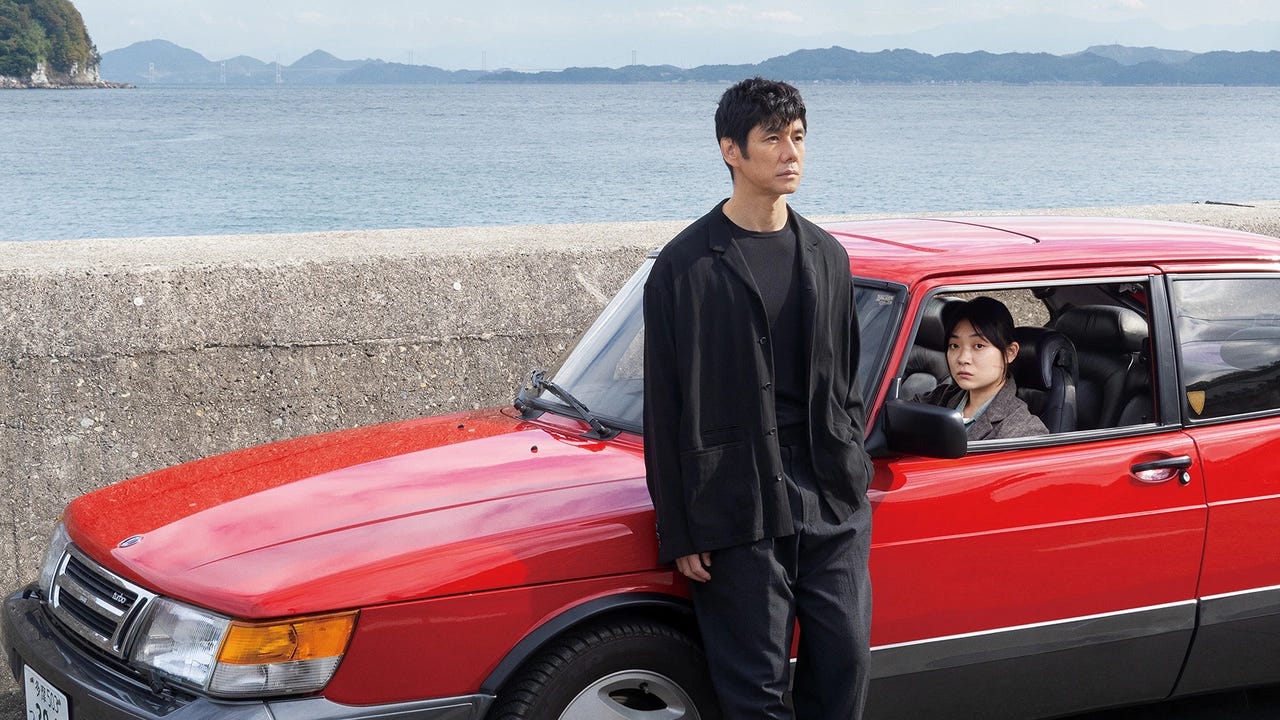Step into the classroom.
You’re a little sweaty from the 3-mile bike ride from your house. Your shirt clings to the small of your back; you feel a bit hot around the neck. You push the stray hair away from your forehead and pull up the socks which have sagged below your ankle. You unzip your bag, take out your computer, plug it in to the display. You’re playing it cool, calm, professorial in front of the 10 or so students already in the room. Collect your breath. You take a swig from the wattle bottle. Head to the water refill station in the hallway. 8 minutes until class time.
You feel good. A top 5 film of yours, Drive My Car, is lined up for discussion today. Yes, it was a risk to assign a film so dear to your heart. But you have faith this will work. And it simply fits the class theme so well—On Art and Artists—that you couldn’t pass it up.
The preclass mingling you pretend not to overhear is encouraging. Louder than usual. They liked this movie! you think. But then you catch it.
“I couldn’t get through the first 30 minutes.”
Heartbreak.
What? She watched 30 minutes of this movie—which they had a week to watch? Their only homework? Sure, it is 3 hours, and it is in Japanese, but you warned them. You sent an announcement! And this is college. They can’t watch one film per week? You quickly condemn the entire generation in a burst of righteous anger and then a beat later forgive them for their naiveté. This is why you’re here, you remember. You try to shake it off.
5 minutes. Need to prepare. You queue up preclass music: the Drive My Car soundtrack and its eponymous first song, a soft and nostalgic melody. You open the Excel attendance sheet, skim your lecture notes and class outline, anticipating and rehearsing the transitions in your head as best you can.
2 minutes.
Look up from the computer nonchalantly. You see Josh gesturing wildly to his peer, Angel raising her eyebrows, Isaiah and every boy in his row staring down at their phones.
1 minute.
Check your phone one last time, turn on Do Not Disturb, skim the email you’re not really reading. It’s time. You look up. 60 eyeballs. 75 minutes of attention, and it’s all on you.
What do you say?
When I tell people that I am teaching an introduction to film class, most of the time I follow it up with a quick word of explanation. “Film studies” as a discipline usually falls within English departments, I clarify. And for the most part, praxis translates between domains. Analyzing plot, breaking down characters, identifying symbols and metaphors and themes, understanding the ambiguity of expressive meaning—these are transferable skills. While the terminology is different, and the artistic forms are clearly distinct (for one, reading literature is harder than watching a film), the comparison is easy to draw: movies are like novels. Long, complex, intentionally and carefully crafted, and worth encountering.
But knowing that a book is like a movie is not the same as understanding it—it’s not the same as knowing what to say to a crowd of undergraduates staring at you, waiting for you to unlock some sort of wisdom for them. When push comes to shove, how does one manage to actually teach a movie? What do you ask them? Lecture on? Assign them to do? Even worse, how do you get them to watch something with interest, even if they hate the first 30 minutes?
These are questions I had week 1 and which I am still trying to answer as we approach week 10. But I have loved every second of it.
In short, we watch clips together from the movies’ best scenes. I establish context for the film and a bit of director background. We discuss narrative and plot (some students simply need help with comprehension, an easy to neglect aspect of instruction). We discuss our affective responses to movies (Did we like this? Why?). We practice mise-en-scène analysis and apply basic cinematographic terms (Is this a two-shot? Medium shot? Tracking? Dolly? Nondiegetic sound? What does this do for meaning?). We try and have some fun.
But importantly, I always finish my week of class with something of a philosophical meditation. I’ll often talk out loud to my wife, Bebe, about this part. When I’m particularly enthused about the upcoming class, I’ll share with her what I plan on saying. She heard my philosophical spiel for Drive My Car and asked, “So, you’re preaching at them?”
Yes, yes I am. If all we do in my classroom—essentially a glorified film appreciation course—is sit around and talk about how cool and fun movies are, I would consider it a failure. Like a novel, but different, movies can instill wisdom and change us for the better. I offer a brief closing lecture (meditation? sermon? benediction?) for each film because I believe every piece of art we encounter has a massive well of potential energy. It is up to us to try to put that potential energy into motion.
To be a good movie watcher means, I think, approaching a film with a sense of responsibility. Although it might sound strange, the viewing of a film should cost us something. “The way to despair is to refuse to have any kind of experience,” Flannery O’Connor has written. I love that idea.
And that’s ultimately what I try to teach my students, to venture vulnerability by placing themselves in front of a piece of art—sometimes a challenging, 3-hour foreign film—and risk having an experience.
A little summary of this week’s film.
Drive My Car is a movie about a stage director, his screenwriter wife, and a chauffeur. Without spoiling too much, I will say this: there is deception, loneliness, an unexpected death, and just a touch of unimaginable grief and misery. But wait! There’s more. After 3 hours, we are ushered into the realm of hope. We see reasons to live on and to do good work, even though the ones we love are dead and gone. In the final account, we find grace, pity, and a peace that only God can provide.
The movie wonderfully weaves together the story of Yusuke, an experimental stage director putting on an adaption of Anton Chekhov’s Uncle Vanya, and Misaki, a taciturn young woman who drives cars for a living. The two are brought together by necessity. Yusuke takes up a two-month artist residency in Hiroshima, and the theatre funding his project does not allow directors to drive themselves to and fro while employed.
The landscapes and the conversations that we see in Drive My Car are as beautiful as they are understated. Passing through Hiroshima, Tokyo, and Hokkaido, we never leave the side of Misaki, Yusuke, or his slick, red 1990s Saab 900 Aero.
It’s a movie about the power of aesthetic experience and the grace we find in the company of others, with Chekhov’s play cleverly at the center (followed by Yusuke’s adaption and then Drive My Car itself). Yusuke tells his young, struggling actor at one point: “When you say [Chekhov’s] lines, it drags out the real you…Yield yourself and respond to the text…The text is questioning you.”
There is a stunning confluence between the words of Uncle Vanya, recited often verbatim in the film, and Yusuke’s struggle with misery, work, and what it means to persist. I’m still not quite sure how director Ryusuke Hamaguchi did it.
Below, I offer a brief excerpt from my lecture notes (with slides!). If you’re already bored at this point, I won’t be offended if you click away. Seriously. Thanks for reading. These notes pick up during the closing minutes of class.
Lecture Notes Excerpt - Week 6, Drive My Car
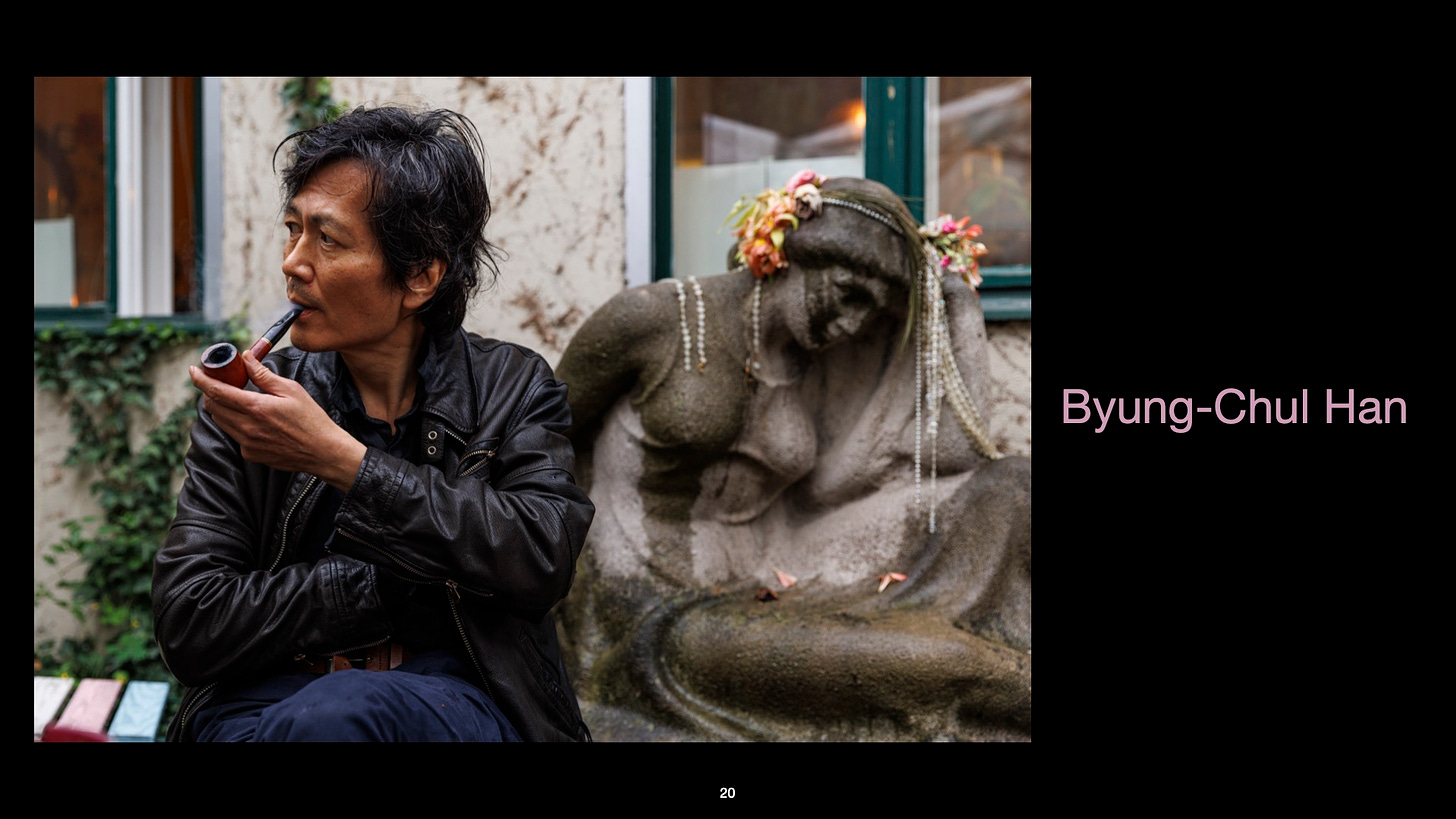
One of my favorite living philosophers is a man by the name of Byung-Chul Han. (Funny, we almost always think of philosophers being old dead guys, but they still exist!)
He writes a lot about contemporary society, technology, and community. And he argues that there are certain things in our life that are worth preserving in order to feel a sense of belonging, a sense of being-at-home.
One of these rituals is mourning itself—grieving someone who we love; we much too easily try to “pass over” the death of a loved one, as if we are meant to just forget them and begin becoming productive members of society, all alone, never truly with others. He argues it is OK to be unhappy, unproductive—to settle into a state of grief, and in fact we should. Doing so as a community, he argues, is part of what it means to be a healthy and full human:
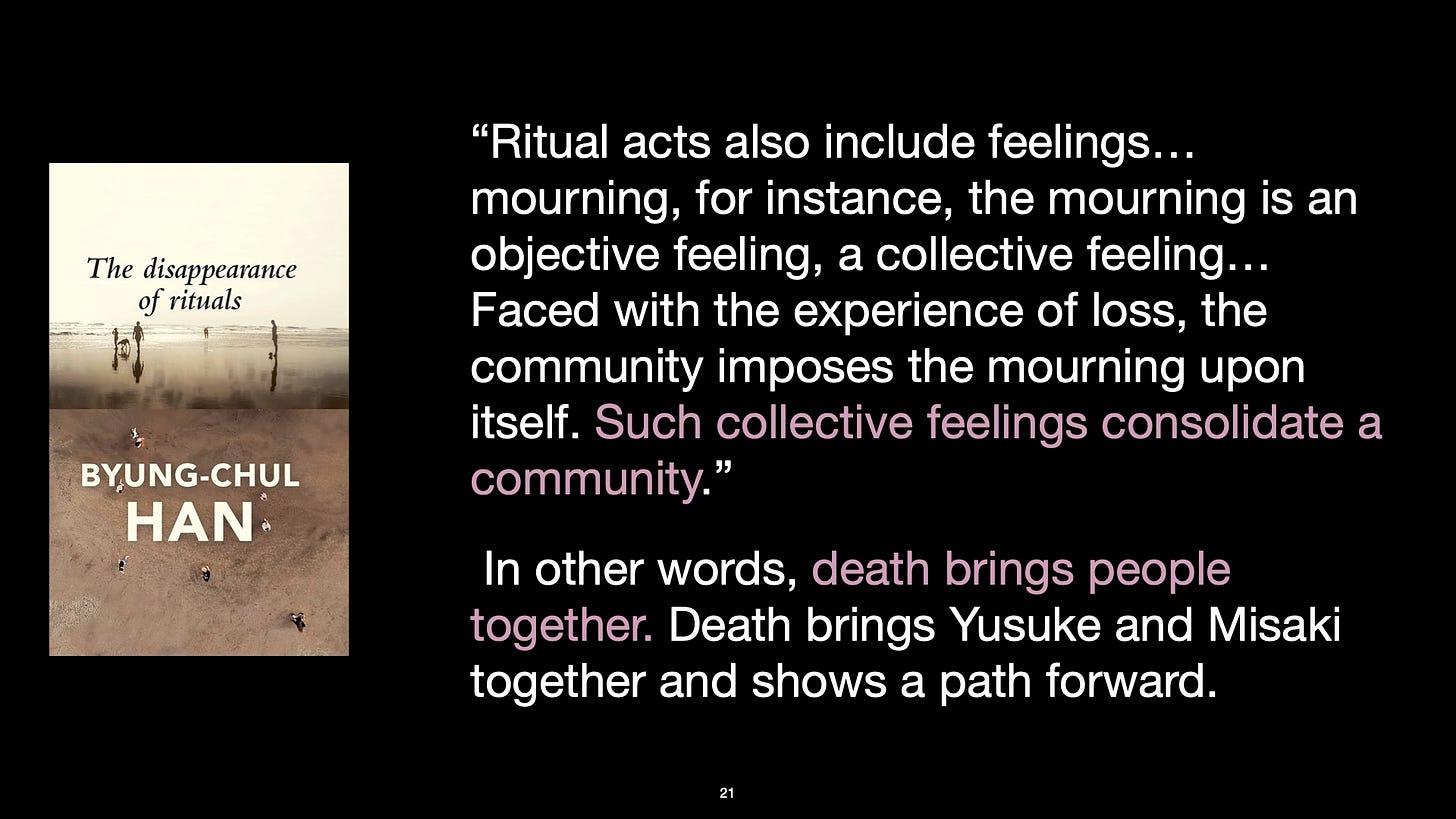
Understanding all these things—and the way a movie is broadly structured—can help us make an argument about the film.
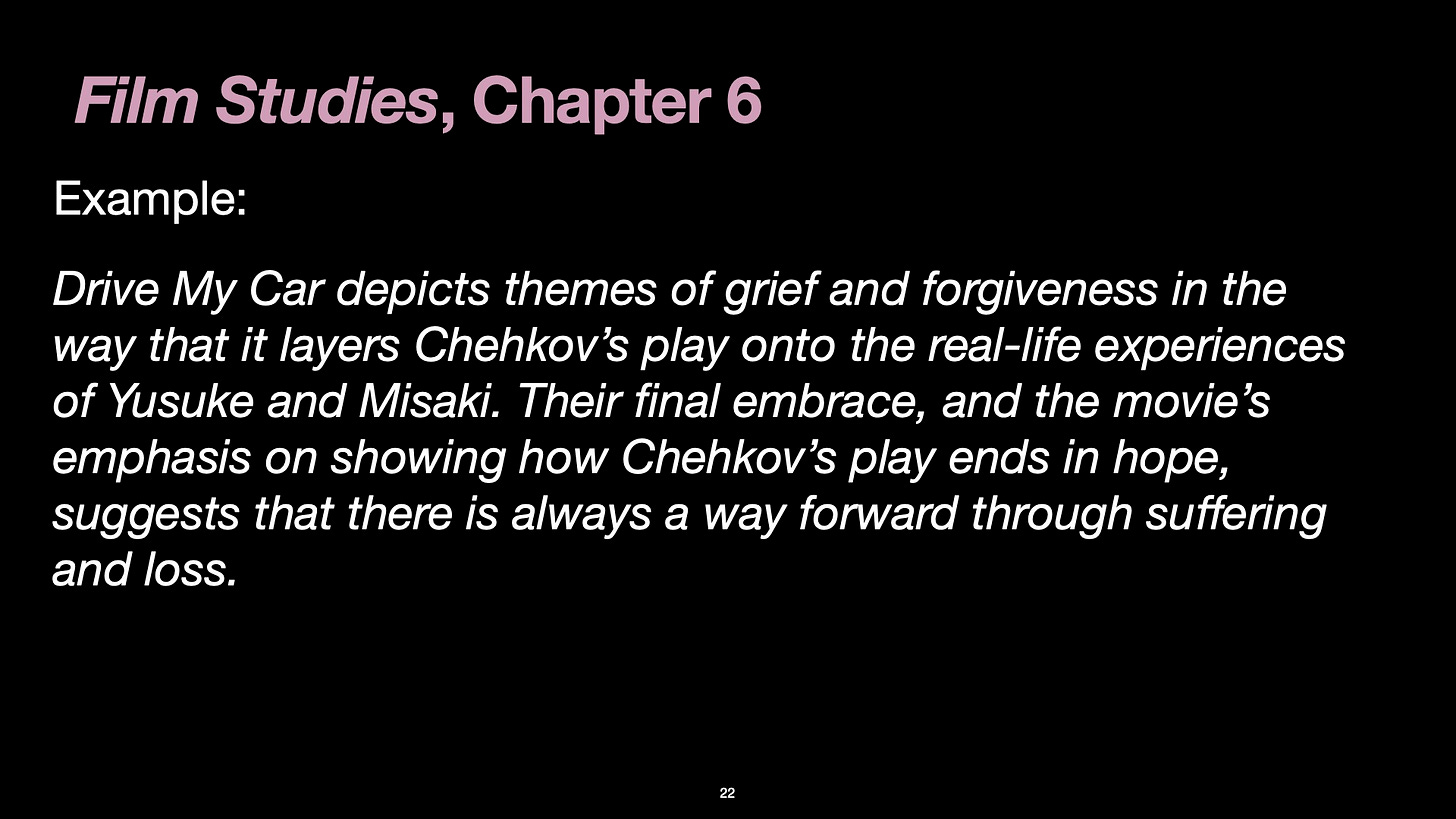
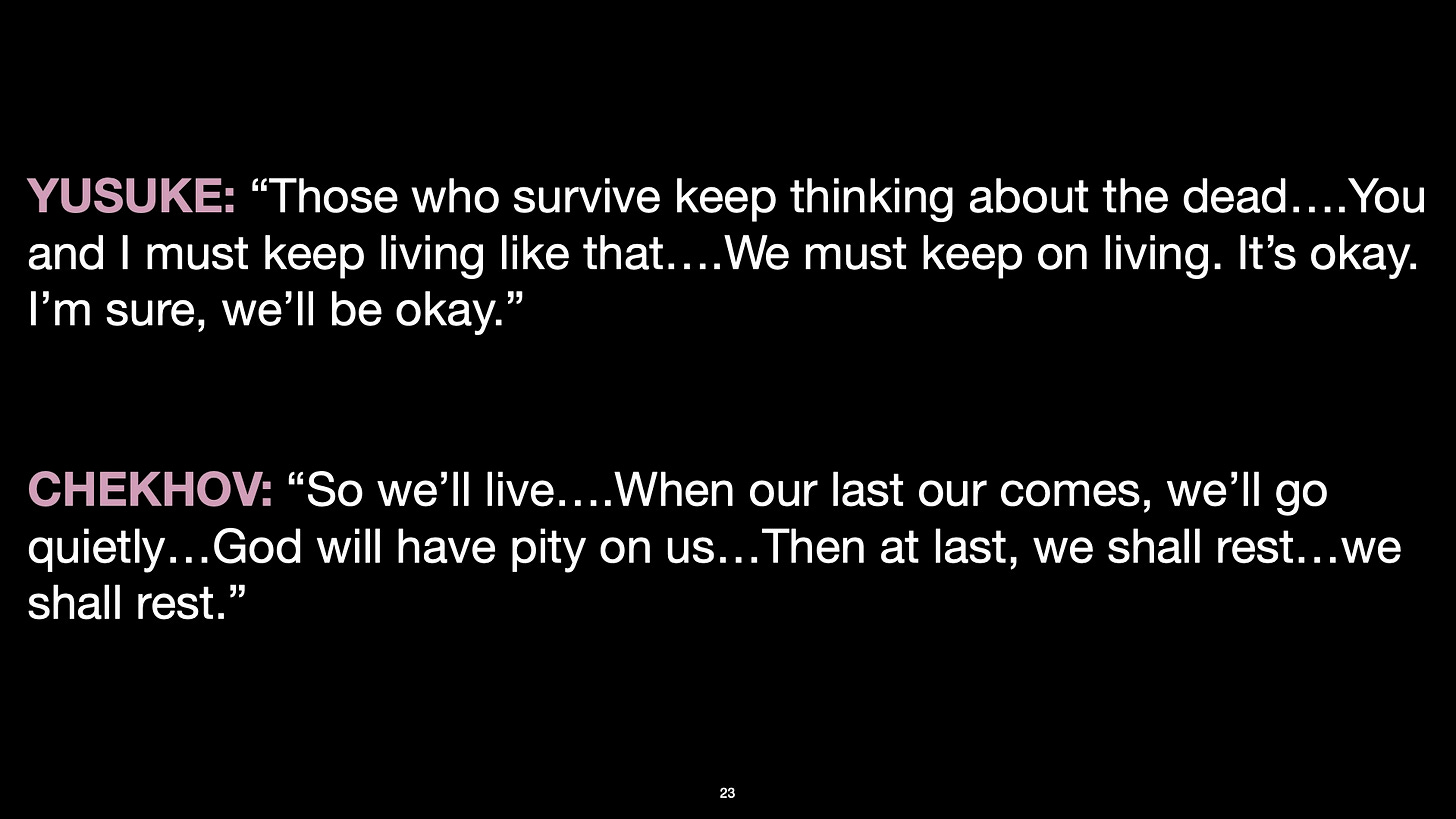
“So we’ll live….When our last hour comes, we’ll go quietly…God will have pity on us…Then at last, we shall rest…we shall rest.”
You finish your mini-lecture. You tell your students to have a nice weekend and send them off into the world, looking a few in the eye. You take a swig of water as they exit. A few warmly call back to you, “thanks!,” “have a nice weekend,” “bye!” You hope something, anything you said sticks. And you rest from your work.



